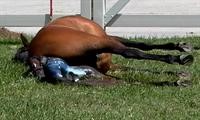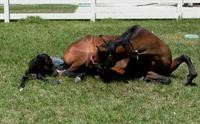Please note, graphic photographs included below. David P. Beehan, DVM S.K. Lyle, DVM, PhD, DACT N.L.Walker, PhD
Original Publish Date February 2014 Stage 2
Pregnancy in the horse is approximately 340 days, but may vary between 320-380 days. Unfortunately there can be large variance between mares during the prepartum period, with the changes and signs of parturition being mare dependent. Parturition is defined as the three stages involved in giving birth. When compared to other species, parturition in the mare is an explosive process. As a result problems can occur very quickly, requiring immediate veterinary intervention. Udder development may occur 4-6 weeks before parturition. The mammary glands will enlarge and some minor ventral edema (swelling along the abdomen) may be noted. Waxing (collection of a sebaceous secretion on the end of the teat) usually occurs within 24 hours of parturition, but may occur up to 4 weeks beforehand. Some other things to note are the tail-head and pelvic ligaments that become relaxed as parturition nears; however this may vary significantly between mares. WHEN TO CALL A VET: o A mare that is leaking milk before parturition. o A mare close to her due date that still has a “Caslicks” (sutured vulva) stitch in place. o If abdominal edema becomes excessive and painful; reluctant to walk. o Any signs of Colic. o Any signs of vulval/vaginal discharge. o Bloody discharge from the udder. Parturition can be divided into three stages. Stage 1: The majority of mares foal at night, usually between 11 pm and 4 am. This is when they feel that it is safe to foal. Keeping a quiet environment and no excessive disturbing of the mare during this period can be conducive to foaling. The first signs that parturition is imminent are similar to mild colic. These include sweating, restlessness, pawing, flank watching, excess tail movement; they may stop eating for brief periods. These changes are brought about as the start of uterine contractions that cause sharp bouts of pain for the mare. Stage 1 may last from 1 to 4 hours, but may be as short as 30 minutes. It ends with the rupture of the placental chorioallantoic membrane and the escape of the allantoic fluid. WHEN TO CALL A VET: o If the mare appears to be in excessive pain. o If the mare appears to be going through repeated violent contractions without any progress. o Should the placental chorioallantoic membrane not rupture, and appear from between the vulva with no sign of the foal. It is also known as “Red-bag” delivery. Stage 2: This is the fastest stage of parturition. Normally it will last between 10-30 minutes. After the allantoic fluids have been expelled the mare may lie down on her side, with her legs and head in full extension. Abdominal contractions will now become apparent. The amnion membrane should appear 5 minutes after chorioallantoic rupture (breaks her water). During this period the foal is moving into its final positional and postural changes. At foaling, a foal should be in anterior presentation (head and front legs first), dorso-sacral position (the back of the foal should be closest to the mares spinal column) with both limbs fully extended. It is normal for the front legs to be coming together and the head should present in extension over the front feet. The presence of the amnion and the foal’s legs in the birth canal should stimulate strong contractions that will deliver the foal. Soon after the amnion is visible a forelimb should appear covered by this membrane, then the second forelimb, and finally the head. The foal’s head may first appear inside the amnion, which may not break until the foal is half delivered. The withers then appear, followed by the hips and finally the hind limbs. After the foal has been delivered the mare may take a rest period; frequently the hind legs are still inside the birth canal during this resting period. Although unusual, some mares may deliver the foal standing up. WHEN TO CALL A VET: o If no progress is visible twenty minutes after the chorioallantoic membranes have ruptured. o If only a single limb is visible with no progress. o If both forelimbs are visible up to the carpal joints and the head has not appeared. o If the head is visible before the forelimbs. o When the feet first appear, and the soles of the feet are pointed towards the mares tail. o If the foal is out and the amniotic membranes are still covering the foal. Stage 3: The final stage of parturition is the passing of the fetal membranes (placenta). This typically occurs within 3 hours of foaling. A complete placenta should consist of a body, two horns and an umbilical cord. There should only be one tear through which the foal is delivered. The placenta should be laid out flat for examination and both the fetal and maternal sides should be inspected before it can be determined that no pieces were retained. It is recommended to save the placenta (refrigerated) so that your veterinarian can examine it for abnormalities and to verify that the entire placenta was delivered. WHEN TO CALL A VET: o If the placenta has not been passed by 3 hours after foaling. o After examination, a complete placenta has not been passed. o If the mare has a fever, is depressed, laminitic, has congested/toxic/pale mucous membranes or elevated heart or respiratory rates, or shows signs of colic after foaling. If you are having an emergency and need veterinary attention please contact: Equine Health Studies Program School of Veterinary Medicine Louisiana State University Baton Rouge, LA 70803 Telephone: (225)-578-9500 |








When I originally commented I clicked the “Notify me when new comments are added” checkbox and now each
time a comment is added I get several e-mails with the same comment.
Is there any way you can remove people from that service?
Appreciate it!
We’ll speak to our web guru about this problem. Thanks for the heads-up.